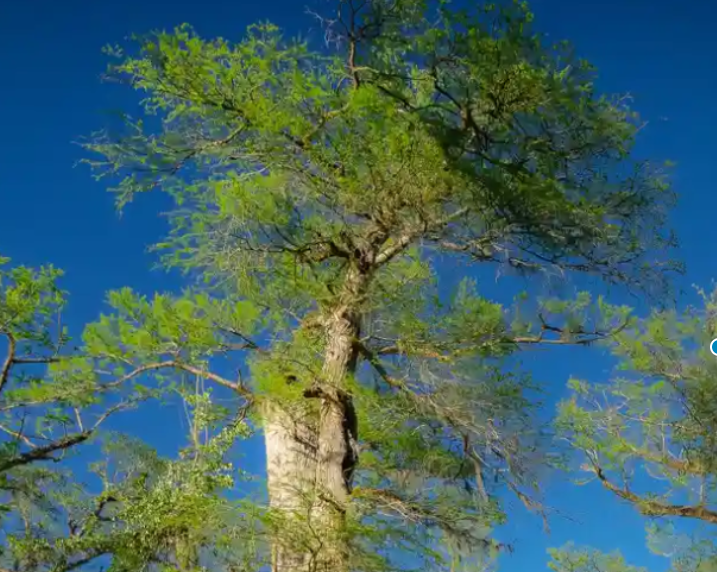
In North Carolina, there lies a wizened bald cypress. It’s withstood its ground for over 2,600 years. The tree, which lives among a cluster of eastern bald cypresses much like itself, differentiates itself from its neighbors by withstanding the test of time. Experts date the tree’s origin to around 605 BCE, making this the oldest tree in Eastern North America and the fifth oldest still standing worldwide.
If this tree – and any of the other ancient ones – could talk, it may tell us that climate change has made it increasingly hard for trees to survive. Scientists realize there is much to learn from trees such as these. They may help piece together who humanity can adapt to the unprecedented effects of climate change.
Julie Moore, a retired botanist and former coordinator at the US Fish and Wildlife service, says of these trees, “they have personality.” Moore, who has mapped wetlands for years, admits to being familiar with “every big swamp in the United States in the South.” She knows when she sees trees like this ancient bald cypress that “they are different.”
In 1985, Moore introduced this special tree to David Stahl. Stahl is a dendrochronologist. As a result, he used tree ring mapping and radiocarbon dating on the bald cypress. This led to his discovery of a different bald cypress, which is often referred to as “Methuselah” after the biblical old timer. After coring hundreds of trees, he discovered this one that predates “Methuselah” by nearly a thousand years. It’s a truly rare find indeed.
Encouraged by the discovery, Stahl and his team soldiered on with their Black River research, as it had come to be known. They worked to reconstruct rainfall patterns while also mapping the ancient forest. Their research showed that intensifying heatwaves, storms, flooding and drought compounded with warm temperatures are responsible for problems with plant growth, resilience and production.
This is unfortunate if not dangerous. As Stahle says, “The principal threat to our forests is people and human activity. One consequence of human activity is climate change.”
Making matters worse is the fact that about six feet of elevation separates these trees from the Atlantic Ocean. With sea levels looking to rise at 20 to 30 feet within the next 100 years, the world’s oldest cypress may be underwater as early as 2080.
To put it mildly, “that’s a really serious threat”. Harvard Forests senior ecologist, Neil Pederson, goes on to say that he sees “sea level rise as a train alarm on a really long, overloaded train. And it’s going to take a long time for that train to slow down.” Pederson, for his part, is just one of a team of researchers behind a 2014 study which found that increasing drought conditions, coupled with extreme events of the past, leading to unusually high tree mortality rates, could be a forecast of the future. As he says, “Even though these forests seem to change slowly over time. Every once in a while these things, like black swans…come and change an ecosystem.”
A 2020 study found that despite the fact that older trees can adapt to stresses and migrate to other locations as conditions become less favorable for their overall survival, it is unlikely that these factors will be enough to keep them alive. Nate McDowell, an earth scientist at Pacific Northwest National Laboratory and lead author of the study, describes trees as functionally ‘sweating’ because of warming temperatures. This causes a reduction in plant activity overall.
With over a third of the world’s old-growth forests dying out between 1900 and 2015, “all the models, all the projections, everything points in the same direction: that we’re going to lose trees.” McDowell’s prediction is supported by years of recently documented increases in the mortality of older trees, which researchers are identifying across the globe. For example, did you know that last year alone more than 10% of all mature sequoias met their demise?
When trees die it impacts their entire ecosystem. When you have changes “in the plant community, which is really the foundation for the whole forest, you in turn see changes in rodents, birds, even large mammals,” according to plant ecophysiologist Angelica Patterson. In 2018, a study showed that tree loss in the Pacific Northwest can affect climate change in the Eastern part of the United States. Basically, old-growth forests act as ‘carbon sinks’, meaning that they sequester and store carbon emissions. In this way, they accumulate carbon for centuries. If they die, that carbon gets released back into the atmosphere. This creates a vicious cycle which perpetuates the negative effects of climate change. Forest loss can even contribute to the disappearance of natural coastal barriers during storms.
We know this is sobering news but we feel we must bring the facts to you. It doesn’t help to bury our noses in the metaphorical sand. Climate change is real and it’s impacting not just our trees and plants but us as well. We hope that you enjoyed this article and appreciate the research and planning that goes into bringing this information to you each and every week.











